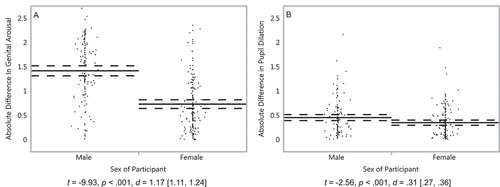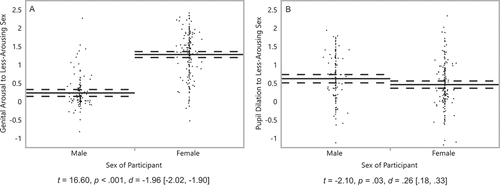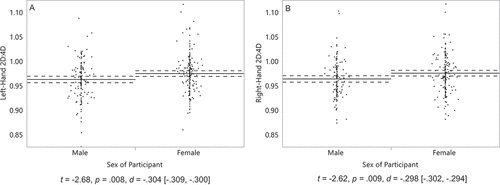Figures & data
Figure 1. Genital arousal and pupil dilation of men and women to sexual stimuli. Absolute difference between stimuli featuring males and stimuli featuring females in (a) genital responses of 126 men and 168 women and (b) pupil dilation of 118 men and 155 women. On the Y axis, scores reflect the absolute difference between sexual arousal to males and females, standardized within participants. Solid lines represent group means, and dashed lines their 95% confidence intervals. Dots represent participants’ average scores. Captions are independent-samples t-tests, with effect sizes and their 95% confidence intervals.

Figure 2. Genital arousal and pupil dilation of men and women to sexual stimuli. Minimum arousal to stimuli featuring males and stimuli featuring females – whichever is lowest – in (a) genital responses of 126 men and 168 women and (b) pupil dilation of 118 men and 155 women. On the Y axis, scores reflect minimum arousal values, standardized within participants. Solid lines represent group means, and dashed lines their 95% confidence intervals. Dots represent participants’ average scores. Captions are independent-samples t-tests, with effect sizes and their 95% confidence intervals.

Figure 3. Left-hand 2D:4D (a) of 139 men and 179 women, and right-hand 2D:4D (b) of 139 men and 178 women. On the Y axis, 2D:4D is the length of the index finger divided by the length of the ring finger. Solid lines represent group means, and dashed lines their 95% confidence intervals. Dots represent participants’ scores. Captions are independent-samples t-tests, with effect sizes and their 95% confidence intervals.

Table 1. Multiple regression analyses for sex and left hand 2D:4D predicting absolute difference in genital arousal and response to the less-arousing sex (N = 294) and pupil dilation (N = 273)
Table 2. Multiple regression analyses for sex and right hand 2D:4D predicting absolute difference in genital arousal and response to the less-arousing sex (N = 293) and pupil dilation (N = 273)
